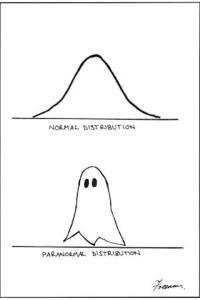Psychology by the numbers

Psychology would seem, at first look, to be one of the sciences with the least involvement with mathematics. After all, psychology is all about the mind, all about people – what does mathematics have to do with that?
Well, as it turns out, a lot! The main reason is that mathematics is of use, is that psychology has one aspect that most people don’t consider. Most think of psychology as relating to a single person, but there is one other consideration. We also care about how groups respond, and how the individual compares to the group.
To this end, we need a simple way to describe groups, so we can compare them to each other and to the individual. The best way to do this reliably is to use mathematics – and we are interested in two particular concepts – the idea of what the average value of a group is, and the idea of how much the group is distributed.
In this post, I will cover the basic mathematics you will need to describe these concepts – which you will need for your Empirical Research Activity (ERA) report that is due at the end of term 4. The mathematics is *not* difficult, and you will be able to the majority of it on your computer, by using microsoft excel (or a similar piece of software).
So, let’s hit the concepts then. Here they are, with the formal language we use to describe them:
1. Measures of Central Tendency: otherwise known as the average, there are three possible choices: Mean, Median & Mode. We are most interested in the mean. You are probably familiar with these from Maths in years 8 and 9.
2. Measures of Spread: these are probably newer to you, but you may have done them recently. The ones we are interested in are Interquartile range and standard deviation.
The first thing you need to do is access the file with the results from our Perceptions of Mental Health survey. They are stored on a google drive accessible to you with your Melba Login. Here is the link: ERA Files.
The mathematics and techniques of calculating the average (“mean”) and spread (“standard deviation”) are covered in this video.
I will explain more after I know some of you have read this far, and watched the video, I will update this post with more information after six students have commented on this post. It’ll be interesting to see who comments, and how long it takes…
I hope you’re enjoying your holidays and making progress on your folio project.
Explore posts in the same categories: Assessment, Mathematics, Psychology, technology, Year 10
September 30, 2013 at 5:24 PM
Thanks for the stuff 🙂
October 1, 2013 at 10:16 AM
Hi Kahlan,
Were you able to download it?
How is your Folio of work outcome going?
Mr.G
October 4, 2013 at 1:14 PM
I was able to download it fine and I have got it.
My folio work is going well, I have completed all of section 1 and I’m now working on the ERA but at this point in time it has become rather frustrating and finding it a little difficult.
October 4, 2013 at 3:04 PM
You only have to write your hypothesis for your ERA – no more!
October 4, 2013 at 3:53 PM
That’s all I am doing but I am still finding it difficult on what to write for it.
October 21, 2013 at 4:51 PM
Hi, I have my Qualitative and Quantitative Data powerpoint to submit but I don’t know how to. Where do I submit it to?
October 21, 2013 at 9:03 PM
Slideshare.net is probably the easiest.
October 21, 2013 at 9:30 PM
I emailed it to your school gmail. I won’t be able to upload it to the website until tomorrow.
October 22, 2013 at 3:21 AM
Hello , this is my PowerPoint. It would have been posted earlier but my iPad was doing some weird things. Hopefully this submits it time. Argh.
http://prezi.com/wzw-vmej2pre/?utm_campaign=share&utm_medium=copy&rc=ex0share